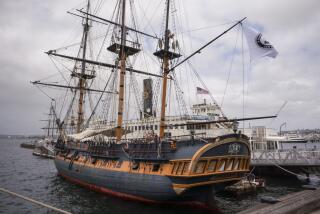Inaugural Trips Have Cachet, But Can Be Troublesome : Cruises: Passengers who like to be first on deck may not find everything shipshape aboard.
In the vocabularies of certain travelers, there are few words as seductive as âinaugural cruise.â
To committed cruise ship passengers, who prize comfort and familiarity at least as highly as novelty, an inaugural cruise promises the best of both worlds: Itâs an adventure, yet each step of the way is largely shaped by tradition, from the tuxedos on formal nights to the commemorative gifts offered the captain by local worthies at each new port. Last month I glimpsed this world aboard the Aruba-to-San Francisco cruise of Royal Cruise Lineâs Star Odyssey--not a new ship, but a newly acquired ship (it formerly sailed as the Royal Viking Star) with a new crew and $20 million in renovations to go with its new name.
A maiden cruise is an intriguing spectacle, and the idea of it might well attract a traveler who has never cruised before. Beyond that, there are a lot of inaugurations out there: The Cruise Lines International Assn., which counted 131 ships in the North American cruise market at the end of 1993, reports five inaugurals scheduled for this year, seven more next year, and 10 more in 1996. (Cruise company catalogues identify inaugural offerings and, in addition, can provide useful clues to a lineâs character and target audience.)
But newcomers, beware. If luxury, ease and flawless repose are what youâre after--and those are usually the big selling points for cruising--youâre far more likely to find them on a veteran vessel. On a maiden cruise, things inevitably go wrong--sometimes small things, sometimes large. (The most dramatic example of the latter, of course, is the Titanic, which was on its inaugural cruise when it ran into that iceberg off Newfoundland in April, 1912.)
Troubles these days are more likely to be on the order of tepid soup, idle Jacuzzis, or flubbed plumbing, but since the average cruise passenger pays $175-$225 per day, such flaws are closely watched.
One advantage to inaugural trips can be price. After years of selling inaugurals at a premium because of high demand, cruise lines now often offer them at the same rates as more conventional cruises, and sometimes for less, especially if the itinerary is an awkward one designed to get the ship in position for its next cruise.
Itâs also true--though no traveler should choose a cruise on this basis--that cruise line officials pay particular attention to mishaps on inaugural cruises, and sometimes try to soothe passengers and control public-relations damage afterward by offering make-good discounts on future cruises. By the end of the American Family Cruisesâ snafu-ridden first journey last December, the companyâs executives were promising free future cruises to 1,000 parents and children.
Beyond the price, the attractions of inaugurals tend to be more intangible. A passenger becomes part of history, and gets to prowl new decks, explore new cabins, pass judgment on the interior design, and probably be closely listened to by crew members and others eager for feedback.
A newcomer on an inaugural cruise will also find himself or herself in the company of cruise junkies, a fervent and affluent bunch so in love with cruising that theyâre quick to board a new ship, and not all that concerned about the itinerary.
Travelers should note that all inaugurals are not created equal: Some ships undergo shakedown cruises to work out kinks before taking on passengers for their inaugural voyages. (Crystal Cruisesâ brand new Crystal Symphony, due to embark its first passengers next May in New York for a trans-canal cruise to Los Angeles, will first cross the Atlantic from its shipyard in Europe.) And some companies have so much experience in adding new ships that floating a new one can be very nearly business as usual. (Carnival Cruise Lines, with a fleet of nine and two more due in the next 18 months, fits into that category.)
And what exactly can go wrong on an inaugural cruise?
First, keep in mind that the Star Odysseyâs Aruba-San Francisco quasi-inaugural cruise last month was viewed as an overall success. Port calls in Curacao and Costa Rica went nearly flawlessly; the Panama Canal transit was faster than most. Yet the following first-week glitches cropped up:
The galleyâs metal plate covers turned out to be the wrong size, allowing many meals to cool before serving. Many cabins, including some pricey suites, had undersized or missing shower curtains. The decks were unvarnished. The hamburger-and-hot-dog grill on the top deck was closed. Laundry service ran a day behind. And after a few days, an unpleasant smell spread along the hallways of the seventh deck. And in an incident that may or may not have been inauguration-related, near Curacao the ship rolled severely, half-emptying the pool, dislodging and smashing scores of bottles, and staggering hundreds of brittle-boned passengers.
âIâm not a negative person,â said Doris Luebke of Glendora, veteran of a dozen cruises and two previous inaugurals. âBut Iâm having a hard time being positive on this cruise.â
Yet she was outnumbered. âItâs a little like buying a new house,â said Louise Eder of La Habra. âThereâs bound to be something wrong.â âItâs a little noisy, and a little smelly, but the decor is beautiful,â said Hanna Kuehn of Moscow, Idaho, who was on her 20th Royal cruise. âYou have to give them time.â
More to Read
Sign up for The Wild
Weâll help you find the best places to hike, bike and run, as well as the perfect silent spots for meditation and yoga.
You may occasionally receive promotional content from the Los Angeles Times.







